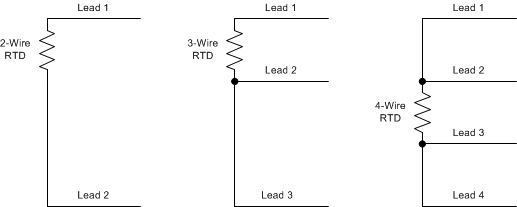SBAA275A June 2018 – March 2023 ADS1120 , ADS112C04 , ADS112U04 , ADS1147 , ADS1148 , ADS114S06 , ADS114S06B , ADS114S08 , ADS114S08B , ADS1220 , ADS122C04 , ADS122U04 , ADS1247 , ADS1248 , ADS124S06 , ADS124S08 , ADS125H02 , ADS1260 , ADS1261 , ADS1262 , ADS1263
- A Basic Guide to RTD Measurements
- 1RTD Overview
-
2RTD Measurement Circuits
- 2.1 Two-Wire RTD Measurement With Low-Side Reference
- 2.2 Two-Wire RTD Measurement With High-Side Reference
- 2.3 Three-Wire RTD Measurement, Low-Side Reference
- 2.4 Three-Wire RTD Measurement, Low-Side Reference, One IDAC Current Source
- 2.5 Three-Wire RTD Measurement, High-Side Reference
- 2.6 Four-Wire RTD Measurement, Low-Side Reference
- 2.7 Two Series Two-Wire RTD Measurements, Low-Side Reference
- 2.8 Two Series Four-Wire RTD Measurements
- 2.9 Multiple Two-Wire RTD Measurements
- 2.10 Multiple Three-Wire RTD Measurements
- 2.11 Multiple Four-Wire RTD Measurements in Parallel
- 2.12 Universal RTD Measurement Interface With Low-Side Reference
- 2.13 Universal RTD Measurement Interface With High-Side Reference
- 3Summary
- 4Revision History
1.3 RTD Wiring Configurations
RTDs are made in three different wiring configurations described in this application note. Each wiring configuration requires a different excitation and circuit topology to reduce the measurement error. The three different wiring configurations are shown in Figure 1-3.
 Figure 1-3 Two-Wire, Three-Wire, and Four-Wire RTDs
Figure 1-3 Two-Wire, Three-Wire, and Four-Wire RTDsIn the two-wire configuration, the RTD is connected through two wires connected to either end of the RTD. In this configuration, the lead wire resistances cannot be separated from the RTD resistance, adding an error that cannot be separated from the RTD measurement. Two-wire RTDs yield the least accurate RTD measurements and are used when accuracy is not critical or when lead lengths are short. Two-wire RTDs are the least expensive RTD configuration.
In the three-wire configuration, the RTD is connected to a single lead wire on one end and two lead wires on the opposite end. Using different circuit topologies and measurements, lead resistance effects can effectively be cancelled, reducing the error in three-wire RTD measurements. Compensation for lead wire resistance assumes that the lead resistances match.
In the four-wire configuration, two lead wires are connected to either end of the RTD. In this configuration, the RTD resistance may be measured with a four-wire resistive measurement with superior accuracy. The RTD excitation is driven through one lead on either end, while the RTD resistance is measured with the other lead on either end. In this measurement, the RTD resistance is sensed without error contributed from the lead wire reacting with the sensor excitation. Four-wire RTDs yield the most accurate measurements, but are the most expensive RTD configuration.